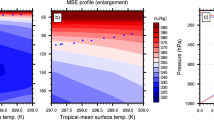Summary
In this paper, an attempt is made to examine the influence of the physical forcings of an atmospheric general circulation model (AGCM) in the reduction of the systematic errors of the tropical forecasts. A number of major modifications in the parameterization of physical processes were carried out in the operational forecasting system of the European Centre for Medium Range Weather Forecasts (ECMWF) during the period 1984–88 largely in an attempt to reduce the conceptual weaknesses in their formulation. A large number of studies (Slingo et al., 1988; Tiedtke et al., 1988; etc) have demonstrated the positive impact on the reduction of tropical forecast errors to various changes in the treatment of physical processes in the ECMWF model.
Keeping in view of these facts, the evaluation of the systematic errors of the ECMWF tropical forecasts is carried out for a period prior to the incorporation of major modifications in the parameterization of physical processes (1984) and corresponding period after such major changes are implemented in the operational AGCM of ECMWF (1988). The paper describes a detailed comparison of the tropical forecast errors for summer monsoon seasons (June-August [JJA]) of 1984 and 1988 in order to bring out the impact on tropical simulation of various improvements in the treatment of physical processes.
The results demonstrate a dramatic reduction in the systematic errors of the tropical circulation together with an enhancement of the hydrological cycle to a realistic climatological level with the incorporation of major changes in the treatment of physical processes. Similar improvements are also observed in the winter simulation. In spite of major improvements in the simulation of tropical circulation, the nature of the tropical systematic errors of the ECMWF AGCM, however, remains unchanged. Thus, the inference of the study indicates the requirement of a new approach to the problem of parameterization of physical processes particularly, convection, radiation, boundary layer and their interactions for further reduction of the tropical forecast errors.
Similar content being viewed by others
References
Blondin, C., Böttger, H., 1987: The surface and sub-surface parameterization scheme in the ECMWF forecasting system. ECMWF Research Department Tech. Memo. No. 135, 48 pp.
Heckley, W. A., 1985a: Systematic, errors of the ECMWF operational forecasting model in tropical regions.Quart. J. Roy. Meteor. Soc.,111, 709–738.
Heckley, W. A., 1985b: The performance and systematic errors of the ECMWF tropical forecasts (1982–1984). ECMWF Technical Report No. 53.
Illari, L., 1989: The quality of satellite PWC data and their impact on analysed moisture fields.Tellus,41A, 319–337.
Jaeger, L., 1976: Monatskarten des Niederschlags für die Ganze Erde.Berichte des Deutschen Wetterdienstes,139, 18.
Kanamitsu, M., 1985: A study of the predictability of the ECMWF operational forecast model in the tropics. ECMWF Technical Report No. 49.
Miller, M., Palmer, T., 1987: Orographic gravity wave drag: Its parameterization and influence in general circulation and NWP models, Proc. of the ECMWF Seminar on Observation, Theory and Modelling of Orographic Effects, 15–19 Sept. 1986, Vol. I, 283–333.
Oberhuber, J. M., 1988: An atlas based on the COADS data set: The budget of heat, buoyancy and TKE at the surface of the global ocean, Max-Planck Inst. for Meteorology Report No. 15, Max-Planck Institut fur Meteorologie, Hamburg 13, Germany.
Reed, R. J., Hollingsworth, A., Heckley, W. A., Delson, F., 1986: An evaluation of the performance of the ECMWF operational forecasting system in analyzing and forecasting tropical easterly wave disturbances Part I: Synoptic Investigation, ECMWF Technical Report No. 58.
Reed, R. J., Klinker, E., Hollingsworth, A., 1987: An evolution of the performance of the ECMWF operational forecasting system in analysing and forecasting tropical easterly wave disturbances Part II: Spectral Investigation. ECMWF Technical Report No. 60.
Ritter, B., 1985: The impact of alternative treatment of infra-red radiation on the performance of the ECMWF model, Proc. of the IAMAP international Radiation Symp. 1984, Perugia, Italy, 277–280 [Published by DEEPAK, USA]
Simmons, A. J., Burridge, D. M., Jarraud, M., Girard, C., Wergan, W., 1989: The ECMWF medium range prediction models, Development of the numerical formulations and the impact of increased resolution.Meteorol. Atmos. Phys.,40, 28–60.
Slingo, J. M., Mohanty, U. C., Tiedtke, M., Pearce, R. P., 1988: Prediction of the 1979 summer monsoon onset with modified parameterization schemes.Mon. Wea. Rev. 116, 328–346.
Slingo, J. M., Ritter, B., 1985: Cloud prediction in the ECMWF model. ECMWF Technical Report No. 46.
Tiedtke, M., Heckley, W. A., Slingo, J., 1988: Tropical forecasting at ECMWF: The influence of physical parameterization on the mean structure of forecasts and analyses,Quart. J. Roy. Meteor. Soc.,114, 639–664.
Author information
Authors and Affiliations
Additional information
With 14 Figures
Rights and permissions
About this article
Cite this article
Mohanty, U.C., Heckley, W.A. & Ramesh, K.J. A study on the systematic errors of the tropical forecasts: Influence of physical processes. Meteorl. Atmos. Phys. 55, 151–166 (1995). https://doi.org/10.1007/BF01029824
Received:
Revised:
Issue Date:
DOI: https://doi.org/10.1007/BF01029824




